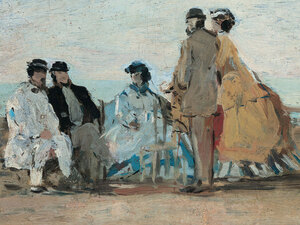Monet was inspired mainly by Eugene Boudin, a landscape artist who specialized in drawing detailed landscapes by the sea, such as Personnages sur la plage de Trouville. Boudin often spent his time at the beach drawing visitors en plein air (as he saw them), and ultimately Monet came to do the same. This painting style was possible largely because of the invention of metal paint tubes, which preserved the moisture of paint better than the bladders of animals that had been used up to the 1840s.

The Salons, official gatherings where artists from around the country could exhibit their works, were still in operation in 1874. In the same year in April, Monet and another group of artists opened up an independent exhibition separate from the Salon. It was here that Monet featured his most distinguishing work, Impression: Sunrise.
It is worth noting that the term "Impressionism" was coined by critics who went to the independent exhibition and looked at Impression: Sunrise. The critics attacked the work for its simplicity, calling it a mere "impression" rather than a painting. Inadvertently, this was how the Impressionist movement got its name.

The work's most prominent feature is an almost-blood red sun that is just beginning to rise over a harbor loaded with the silhouettes of moored ships, buildings, and a few people in canoes moving across the water. The paint strokes used are very broad and visible, giving the viewer just enough information to tell them the impression that is given. Like most of Monet's later works, Impression: Sunrise was painted en plein air, meaning that he painted what he saw at sunrise as fast as he could, because if he had taken too long, the sun would have brightened and changed the lighting that he saw, and capturing light is the main focus of Impressionism. The detail of the work is not unlike James McNeill Whistler's Nocturne in Black and Gold (1875).

Finally, in terms of perspective, the eye level of the work is fairly high on the paper, giving everything an aerial perspective reminiscent of Japanese ukiyo-e ("floating world) woodblock prints. The ukiyo-e prints began making their way into Europe during the Meiji Restoration, which began in 1868 following a revolution in Japan that eventually forced the island nation into opening its ports to commerce with the Western world.
Monet painted Impression: Sunrise in the aftermath of the Franco-Prussian War (1871), a conflict with the German Empire that left France devastated financially. Under the new socialist government, thousands were executed and deported. Among these ranks were Monet, who was forced into exile. He painted this work shortly afterwards in 1872; the textbook claims the possibility that Monet painted it as a means of soothing the trauma brought on him by his displacement.
No comments:
Post a Comment